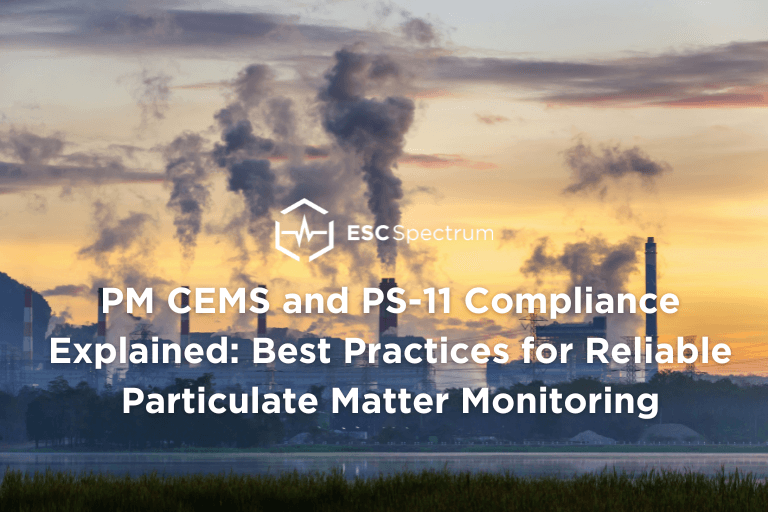Accurately measuring particulate matter (PM) emissions is crucial for complying with environmental regulations and optimizing air pollution control systems. In this blog post—based on an expert-driven presentation from our recent training event—we’ll dive into the essentials of Particulate Matter Continuous Emission Monitoring Systems (PM CEMS), exploring the range of available technologies and prominent vendors in the market. This will cover the certification requirements for PM CEMS, with a special focus on achieving compliance with Performance Specification 11 (PS-11) Correlation. From technical insights on PS-11 to practical advice for PM monitoring and certification, this blog post will equip you to navigate today’s PM monitoring landscape.
PM CEMS Overview
Particulate matter (PM) is a mixture of solid particles and liquid droplets suspended in the air. These particles can vary in size and composition, affecting both air quality and health. PM is generally classified into two types based on particle size:
- PM10: Coarse particles with a diameter of 10 micrometers or less. These can include dust, pollen, and mold.
- PM2.5: Fine particles with a diameter of 2.5 micrometers or less, such as combustion particles and organic compounds, which can penetrate deep into the lungs and cause serious health issues.
How is Particulate Matter Measured?
PM can be measured using various instruments that either monitor concentration or determine particle size distribution. The measurements are usually expressed in micrograms per cubic meter (µg/m³).
- PM Concentration: This indicates the mass of particles in a given volume of air.
- Particle Size Distribution: Instruments designed to categorize particles by size help identify the health risks and environmental impacts associated with different particle sizes.
Types of PM Monitors: In-Situ and Extractive
There are two primary types of PM monitors, depending on the method of sampling:
- In-Situ Monitors: These provide direct, in-stack measurements of particulate matter, capturing real-time data without the need for sample extraction. However, in-situ monitors work best in “dry” stacks, where gas streams are above the dew point.
- Extractive Monitors: These systems are designed for “wet” stacks, where water droplets are present. They extract a sample of the gas for analysis, making them suitable for applications where in-situ measurement is not possible.
The following are some in-situ and extractive products from our suppliers:
PM CEMS and the Impact of MATS
On April 25, 2024, the EPA strengthened its Mercury and Air Toxics Standards (MATS), aiming to further cut emissions from coal- and oil-fired power plants. Among these updates are tighter limits on particulate matter (PM) emissions, which act as indicators for hazardous air pollutants (HAPs) such as arsenic, nickel, and lead. The updated standard reduces the allowable PM emission rate from 0.030 lb/MMBtu to 0.010 lb/MMBtu, supporting improved air quality and reducing associated health risks.
To learn more about MATS regulations, refer to the EPA MATS webpage, or read our blog post: Final Rules – “MATS Residual Risk & Technology Review and Greenhouse Gas (GHG) Performance Standards”.
Understanding PS-11: Correlation Testing for Accurate PM Monitoring
PS-11 is an EPA standard that applies to PM CEMS. It is used to ensure that PM CEMS installed at facilities such as power plants, industrial boilers, and waste incinerators accurately measure particulate matter emissions over time. This standard is important for compliance with environmental regulations such as MATS, where accurate PM data helps monitor and control hazardous emissions. This accuracy is verified through a process known as correlation testing. This involves comparing the output of a PM CEMS against Method 5 measurements, an EPA-approved reference method for measuring PM emissions.
A key aspect of PS-11 compliance is the detuning process, where pollution control equipment such as electrostatic precipitators (ESPs), baghouses, or wet scrubbers are temporarily bypassed to create higher PM loads for testing. Consistency is crucial in this process, and a site walk-down is essential for proper preparation.
Site Walk-Downs include:
- Identifying ash densities, ensuring fly ash is consistently sampled.
- Evaluating flow patterns and stratification within the stack to determine the best PM monitoring locations.
- Properly positioning sampling ports to ensure accurate measurements.
Best Practices for PS-11 Testing and Compliance
To ensure a successful PS-11 correlation test, proper setup and coordination are critical. Here are some best practices:
- Plant Resources: Have a designated staging area, access to adequate power, air compressors, cooling water, and sealed drums containing fly ash.
- Testing Responsibilities: Daily calibrations and operational checks of the CEMS are essential. The plant should maintain steady load conditions during the testing phase, with oversight from plant environmental and operations teams. Stack testers must perform Method 5 runs and analyze correlation curves on-site. An additional party that specializes in Fly Ash Injection, such as B3 Systems, should be responsible for maintaining consistent injection rates for mid and high PM load runs.
- Response Correlation Audits (RCA): PS-11 requires a minimum of 15 test runs, each lasting 60 minutes. These tests, which should span four to five days, evaluate PM emissions under normal, mid-range, and high-load conditions.
PS-11 Quality Assurance and Quality Control (QA/QC)
To ensure ongoing compliance with PS-11, regular audits and checks are necessary:
- Daily: Perform zero and upscale checks to confirm instrument accuracy.
- Quarterly: Conduct Absolute Correlation Audits (ACA) and Sample Volume Audits.
- Annually: Complete a Relative Response Audit (RRA).
- Every 3 Years: Carry out a Response Correlation Audit (RCA).
Key Considerations for PS-11 Compliance
- Location: Monitoring locations are crucial for accurate data. Consider whether your unit can effectively detune or if upstream injection is necessary.
- Timelines: Install PM CEMS early and monitor how they react to operational conditions over time. This helps avoid surprises during compliance testing.
- Expertise: Decide whether to rely on in-house expertise or consultants, particularly for complex tasks like detuning and injection. Ensure that stack testers are experienced in PS-11 compliance and capable of developing accurate correlation curves.
- Communication with Reporting Agencies: States may have different requirements, so proactive communication and pre-testing can prevent delays.
Additional Particulate Monitoring Resources
Ensuring compliance with EPA regulations like MATS and PS-11 is essential for maintaining clean air and protecting public health. By following best practices for PM CEMS monitoring, conducting thorough correlation testing, and implementing rigorous QA/QC procedures, facilities can ensure reliable and accurate PM measurements.
For a better general understanding of CEMS and Emissions Regulations, view our guides on each topic:
- Understanding Continuous Emissions Monitoring Systems (CEMS): A Comprehensive Guide
- The Definitive Guide to Air Emissions Regulations
Want to further your MATS and PM Monitoring knowledge? Participate in one of our upcoming webinars:
- Particulate Matter CEMS: Navigating New EPA MATS Rule Regulations with SICK Sensor Intelligence on November 14 @ 10:00 am – 11:00 pm CDT
- Understanding PM Monitoring Options and Certification Requirements on December 3 @ 10:00 am – 11:00 am CDT
For more information on PM monitoring solutions, contact us today to learn about how our CEMS products and services can help you stay compliant.

Daniel Napolitan
Daniel joined ESC Spectrum in August of 2023 as a Marketing Specialist I. He started this position shortly after graduating from the University of Missouri with a degree in Journalism and Strategic Communications. Prior to working with ESC Spectrum, Daniel gained experience in the digital marketing field doing SEO and keyword research to produce successful organic content. He is now responsible for completing various marketing tasks such as blog writing, social media posts, paid search advertisements, web analytics, and more.

John Cutaia – Field Service Technician V
John has been in the industry for over 32 years, starting with stack testing in 1992. He comes from Luminant Power where he was in the CEMS support group for 10 years, providing support to all power plants on continuous emission monitoring system hardware and software. John also was a training instructor for Extractive and Dilution (CEMS) systems for plant site technicians.

Bobbi Greenwalt – Proposal Engineering Manager
Bobbi joined ESC Spectrum in 2020 and currently is the Proposal Engineering Manager working out of the Pensacola, FL office. Previous ESC Spectrum roles include Proposal Engineer and CEMS Integration Manager. Bobbi came from the utility industry and had 14 years of Instrument and Control experience, including CEMS and project management. She has an AAS in Electrical and Industrial Automation Technology and a BAS in Applied Engineering.


